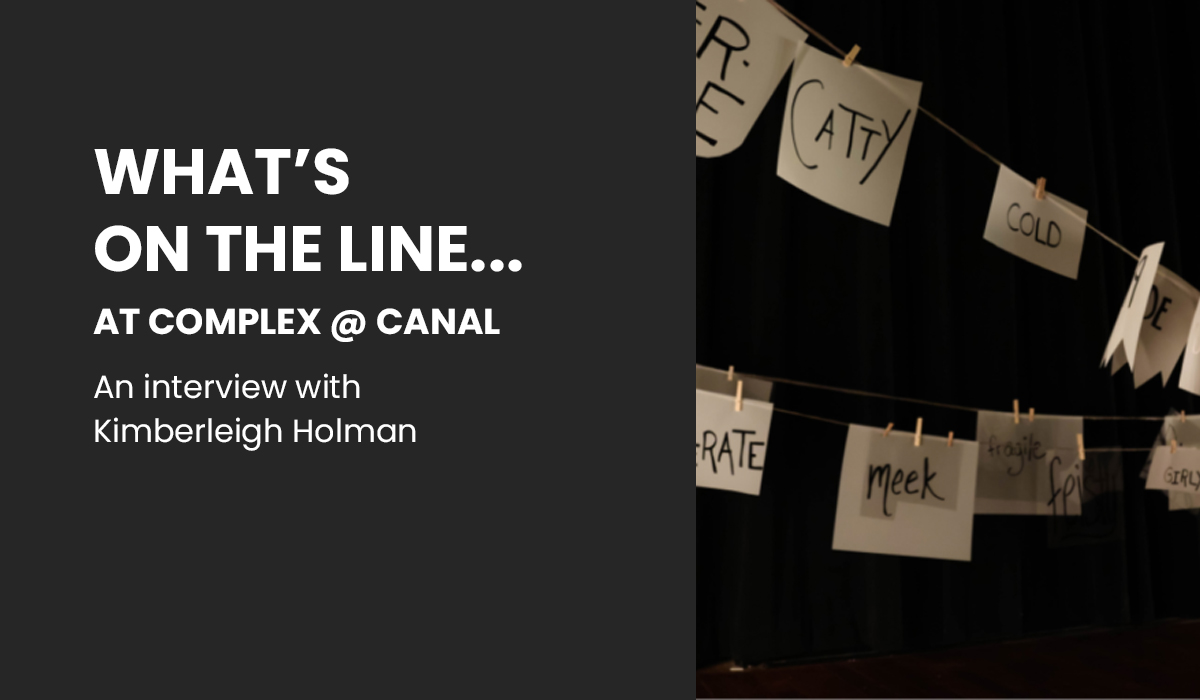
At the beginning of this month, Kimberleigh Holman installed a rendition of her participatory artwork, What’s on the Line… at our Complex @ Canal location (650 E. Kendall St.). We got in contact with Kimberleigh to dive deeper into her work and process. See our written interview below:
We know you around The Dance Complex building as a former CATALYSTS residency artist but, for folks who may not be as familiar with you, could you give them a little bit of your background?
Sure! I’ve been making dance in Boston for thirteen years, mainly as the Co-Founder and Artistic Director of Luminarium Dance, but also in a freelance capacity. I occasionally work as a freelance lighting designer (when schedule permits) and have illuminated a fair amount of Boston dance. I have the good fortune to have worked with several local theatre companies and universities as a movement consultant, collaborator, or choreographer, and I’m currently wrapping up my time as 2021-2022 Boston Dancemakers Resident with a show at the BCA in October, which was also recently awarded a LAB grant. When I write about my work, I like to describe it as a collective body that gravitates to the exploration of human social interaction and behavior, both real and fictitious, miniscule instances or broad patterns, through comedic, dark, sensory or abstract narrative. Much more on my website—kaholman.com.
We are so excited to have you presenting What’s on the Line… at Complex @ Canal this month. What inspired you to create this visual art piece? Why present it in a participatory art design than another form of media?
What’s on the Line… came from an element of my recent work Contradictions + Casual Self Loathing. In the piece we pull word after word out of a laundry basket and hang them on a clothesline onstage˘—all of the words are crowdsourced, and the only stipulation is that they are words usually directed at or used to describe women. Each time we performed this work, audience members were so eager to contribute, it was inherently participatory. When Roe was overturned I felt so wildly helpless, and often still do. I do all the “right things”—showing up, voting, donating—but sometimes they don’t seem to make a difference. After an unsatisfying afternoon of shouting into the social media void and to various echo chambers of friends in the immediate wake of the Roe repeal, I tried to think productively about what I could do. I realized I had a tool that was already successful at sparking conversation and providing a gateway to broader discussion about experiencing life as a woman. It’s very strong on its own, as it’s so heavily populated, and while the materials are visually subtle, the words really jump off the line and grab viewers’ attention.
With this work being a part of the female experience and the recent repeal of Roe v.Wade, how does this variation speak specifically to our current time? Have you found that the work itself has gained a new political or social light than when it was first produced?
I’ve found that WOTL really resonates with viewers, probably in part due to timing, after Roe was overturned, but also due to its universality. I haven’t met a woman that doesn’t carry some baggage, a story about being called one of these words (which are usually derogatory, even if well-intentioned)… even if it’s decades old. The work has always had a strong political message, a great deal of it is about bodily autonomy, so while I don’t think we’ve gained a new political or social light, I think current events that are so detrimental to women (both in action against and attitude towards) have certainly helped amplify the importance of what this work has to say.
I know you took the physical clothesline from a past work, Contradictions + Casual Self
Loathing, how has that work affected this art display? Has the original intention of that past work evolved or changed when you added a piece of it in this new display?
Taking the C+CSL clothesline out of original context to become What’s on the Life… feels like an important footnote became an essay of its own. As a standalone work WOTL gets a moment to breathe, letting viewers process the content at their own speed, instead of one that I prescribe. While the original work for stage hasn’t changed due to its accompanying public art piece, I think those that view WOTL get a fun easter egg if they eventually watch a Contradictions performance. In the work for stage we utilize plastic wrap to bind a performer, limbs tightly wound to the body, making it really hard to move, and making that person really vulnerable to outside force. Eventually, with an immense amount of physical effort, they can break free from the saran wrap, and the shed plastic becomes a future clothesline. It’s a subtle visual, but I find some importance in the idea that we hang these words right on our past struggles.
In continuation of that thought process, I have seen in images that this clothesline of words once lived on the formal concert stage. Have you found a difference in reception, intention, or interaction between presenting it in a public, participatory space rather than a staged setting?
I love this project offstage! Last month it was at an event at Bellforge Arts Center (Medfield), and positioned outdoors in a location where people had to walk by it on their way in. Throughout the event, a few of us took our time hanging words on the line against the installation soundtrack that can be found on my website. Immediately we had observers want to contribute their own words, and then their words turned into anecdotes, and sharing stories brought us together to find intersections amidst relative strangers’ life experiences. This is the experience I want for WOTL—a moment for individuals to consider their histories, but also recognize that the people around them carry their own heavy baggage, too.
After the clothesline comes down, full of words and the stories of others, do you have any future plans for them? May this turn into a future work or find a home in another Rendition?
When the clothesline comes down, I’ll move on (with my new batch of words generated by Kendall Square viewers) and take WOTL to the next site. I have a few interested venues all across New England that want to host the installation in the near future, and I’m really eager to see both interest in the work grow, and also to witness the resulting impact and small scale change we can make through conversation. I’m also very curious to see if we will ever run out of “woman words”, as I’m still regularly being surprised by contributions from viewers.
You can view Kimberleigh’s work at Complex @ Canal for the rest of the month of August! In addition to our interview, you can learn more about Kimberleigh, her work, and beyond in her interview with karen Krolak, Co-Artistic Director of Monkeyhouse and aMaSSiT Mentor.

